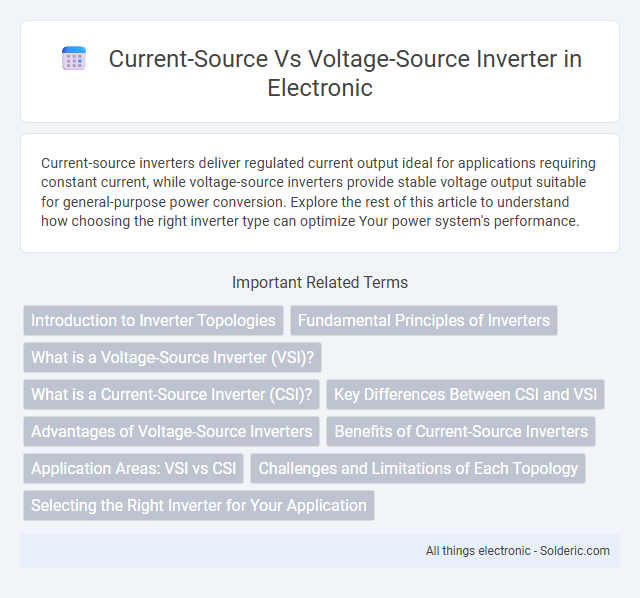Current-source inverters deliver regulated current output ideal for applications requiring constant current, while voltage-source inverters provide stable voltage output suitable for general-purpose power conversion. Explore the rest of this article to understand how choosing the right inverter type can optimize Your power system's performance.
Comparison Table
| Feature | Current-Source Inverter (CSI) | Voltage-Source Inverter (VSI) |
|---|---|---|
| Input | Constant current source | Constant voltage source |
| Energy Storage | Inductor (large) | Capacitor (large) |
| Switching Devices | Thyristors or IGBTs with commutation circuits | IGBTs, MOSFETs, or thyristors |
| Output Waveform | Current-controlled waveform | Voltage-controlled waveform |
| Applications | High power, motor drives requiring constant current | General purpose, motor drives, renewable systems |
| Short Circuit Protection | Stable under short circuit | Damage risk under short circuit |
| Efficiency | Lower due to commutation losses | Higher efficiency, faster switching |
| Complexity | Higher due to current regulation | Lower, simpler control techniques |
| Power Factor | Generally lagging power factor | Can achieve unity power factor |
Introduction to Inverter Topologies
Current-source inverters (CSIs) and voltage-source inverters (VSIs) represent two primary inverter topologies used in power electronics for converting DC to AC power. CSIs utilize a controlled current input and feature a constant current source with an inductive element, making them robust against short-circuit conditions, while VSIs operate with a stable voltage input supported by capacitors, offering flexible output voltage waveforms suitable for various applications. Your choice between these inverter topologies depends on specific operational requirements such as load type, control complexity, and system stability.
Fundamental Principles of Inverters
Current-source inverters (CSI) operate by maintaining a constant current output, using inductors to control and store energy, while voltage-source inverters (VSI) regulate output voltage through capacitive energy storage and switching devices. The fundamental principle of inverters involves converting DC power to AC power by controlled switching, with CSI ensuring a steady current for loads requiring constant current, and VSI providing stable voltage for voltage-sensitive applications. Understanding the differences in energy storage and control methods helps optimize your choice of inverter based on the specific load and operational requirements.
What is a Voltage-Source Inverter (VSI)?
A Voltage-Source Inverter (VSI) converts DC voltage into AC voltage by controlling the switching devices to maintain a constant voltage output. VSI uses a stiff DC voltage source with a large capacitor to stabilize the input voltage, ensuring efficient power conversion and consistent waveform quality. Your choice of VSI is ideal for applications requiring precise voltage control and stable AC supply.
What is a Current-Source Inverter (CSI)?
A Current-Source Inverter (CSI) is a power conversion device that converts DC current into AC current, maintaining a constant current at its input. CSIs are characterized by using inductors to ensure a steady current source and typically operate with voltage-controlled loads. They offer advantages in applications requiring high reliability, such as motor drives and power supply systems, due to their inherent short-circuit protection and smooth current waveforms.
Key Differences Between CSI and VSI
Current-Source Inverters (CSI) use a fixed current input and convert DC current into AC output, whereas Voltage-Source Inverters (VSI) operate with a fixed DC voltage input to produce AC voltage output. CSI typically employs inductors to maintain constant current, making them robust for high-power applications but with slower dynamic response, while VSI use capacitors for voltage stabilization, offering faster response and better voltage waveform quality. Key differences also include the nature of fault tolerance, switching devices used, and control complexity, with VSI being more prevalent in renewable energy and motor drive applications due to versatility and efficiency.
Advantages of Voltage-Source Inverters
Voltage-source inverters (VSIs) provide stable output voltage with fast dynamic response, making them ideal for applications requiring precise voltage regulation. They exhibit simpler control structures and higher efficiency due to the direct connection of a DC voltage source, resulting in reduced power losses. VSIs also support seamless integration with renewable energy systems and energy storage, enhancing overall system reliability and performance.
Benefits of Current-Source Inverters
Current-source inverters (CSIs) offer enhanced fault tolerance and better short-circuit protection compared to voltage-source inverters (VSIs), making them ideal for high-power industrial applications. Their inherent current regulation provides smoother output waveforms and reduces the risk of overcurrents during load changes. You benefit from improved reliability and stable operation in environments requiring robust current control and fault resilience.
Application Areas: VSI vs CSI
Voltage-Source Inverters (VSI) are widely used in renewable energy systems, electric drives, and uninterruptible power supplies due to their ability to provide stable voltage output and high switching frequency. Current-Source Inverters (CSI) find applications in high-power industrial drives, traction systems, and reactive power compensation where robust current control and high fault tolerance are essential. VSI is preferred in consumer electronics and photovoltaic inverters, whereas CSI dominates heavy industrial environments requiring reliable current regulation.
Challenges and Limitations of Each Topology
Current-source inverters (CSIs) face challenges such as limited switching frequency due to reliance on thyristors, leading to lower efficiency and bulkier passive components. Voltage-source inverters (VSIs) struggle with harmonic distortion and need complex control strategies to handle voltage fluctuations and protect semiconductor switches. Both topologies encounter trade-offs between reliability, size, cost, and control complexity in high-power applications.
Selecting the Right Inverter for Your Application
Selecting the right inverter for your application depends on the load type and performance requirements, with voltage-source inverters (VSIs) being ideal for constant voltage applications like motor drives and grid integration, while current-source inverters (CSIs) excel in constant current environments such as welding and high-power industrial processes. VSIs offer better efficiency and simpler control for resistive and inductive loads, whereas CSIs provide robustness against short circuits and are suited for inductive loads requiring smooth current waveforms. Understanding your system's voltage and current needs ensures optimal efficiency and reliability from your inverter choice.
Current-Source vs Voltage-Source Inverter Infographic

 solderic.com
solderic.com